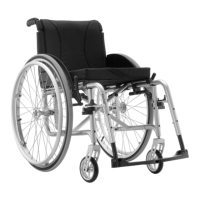BRAKES
Parking brakes
Mounting the parking brake
Diculty:
Tools:
à 5
Position the brake holder B around the front frame tube C.
Place the brake D in the brake holder.
Screw the bolt A with washer into the brake assembly but do not
tighten.
Rotate the brake holder assembly around the frame tube to adjust
the lateral distance of the brake.
Rotate the brake in the brake holder to achieve a horizontal
position of the brake rod E to the tire.
Fully apply the brake and slide it towards the tire until the brake
rod bears flush against the tire.
Release the brake and slide it 3 mm backwards and tighten the
bolt.
Adjusting the parking brake
Diculty:
Tools:
à 5
WARNING!
The parking brakes must be readjusted whenever the rear wheels
are replaced or the wheel camber is changed.
The parking brake function is only guaranteed if the tire has the
corresponding air pressure.
Check the tire pressure in the rear wheels and correct if
necessary.
Slightly loosen bolt A of the brake holder.
Change the position of the brake assembly as described above.
Tighten the bolt.
IMPORTANT!
The force to apply the brake must be 60 N (maximum).
i
Very little force is required for activating and deactivating the
brake. If necessary, a brake lever extension can be mounted.
Visual check
Check that the parking brakes are positioned correctly. The brake is
set correctly if the brake rod depresses the tire by no more than
4mm when the brake is applied. (In the case of push/pull and
standard brakes this will be the case when the brake shoe is approx.
25mm away from the tire when released.)
Function check
Place a weighted wheelchair with parking brake engaged facing
uphill and then facing downhill on a ramp with an incline of 7°.
The wheelchair must not move.
A à 13 Nm

